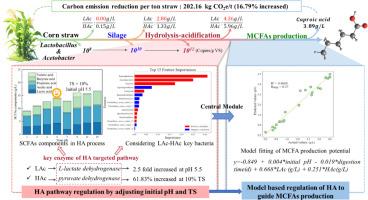A novel sustainable and microbial functional modulation strategy for directly transforming corn straw into high-value liquid biochemicals
IF 12.4
1区 环境科学与生态学
Q1 ENGINEERING, ENVIRONMENTAL
引用次数: 0
Abstract
The natural hydrolysis-acidification (HA) process of straw for medium-chain fatty acid (MCFA) synthesis often faces insufficient selectivity and poor control over the production of lactic acid (LAc) and acetic acid (HAc). Restructuring the microbial community can help regulate the production of LAc and HAc. This study established a fully modularized, resource-recycling system for MCFA production by the targeted enrichment of LAc and HAc functional species. First, within the 20 days of silage, corn straw was rapidly converted to LAc and HAc, with Lactobacillus and Acetobacter being remarkably enriched to 10¹⁰ copies/g VS. Subsequently, the HA module was optimized with a solid content of 10 % and an initial acidic pH of 5.5, which increased the hemicellulose degradation rate from 6.38 % to 17.24 %. While maintaining the HAc concentration, the LAc levels rose from 2.8 g/L to 4.6 g/L, and butyric acid production was suppressed. A predictive model for the caproic acid production, based on LAc and HAc was established and achieved an R2 value of 0.97. Lactobacillus dominated the system, while Acetobacter in the feedstock was gradually replaced by Clostridium, whose abundance increased from 13.87 % to 41.30 %. Syntrophobacter, Syner-01 enhanced the potential for pyruvate metabolism, a key metabolic pathway hub of LAc-HAc production. Key species predicted by random forest analysis were also enriched in reality, which revealed the regulatory mechanism of HA product formation. Furthermore, a life cycle assessment (LCA) demonstrated the environmental and economic advantages of the modularity of our production line, which provides a high-value solution for straw anaerobic digestion.


玉米秸秆直接转化为高价值液体生化物质的新型可持续微生物功能调控策略
秸秆自然水解酸化(HA)合成中链脂肪酸(MCFA)的工艺往往存在选择性不足、对乳酸(LAc)和乙酸(HAc)生成控制不佳的问题。重组微生物群落有助于调节LAc和HAc的产生。本研究通过对LAc和HAc功能物质的定向富集,建立了一个完全模块化、资源化的MCFA生产系统。首先,在青贮20天内,玉米秸秆迅速转化为LAc和HAc,乳酸杆菌和醋酸杆菌显著富集至10¹⁰copies/g VS.随后,对HA模块进行优化,固体含量为10%,初始酸性pH为5.5,将半纤维素降解率从6.38%提高到17.24%。在保持HAc浓度的情况下,LAc浓度由2.8 g/L上升到4.6 g/L,丁酸生成受到抑制。建立了以LAc和HAc为指标的己酸产量预测模型,R2值为0.97。该系统以乳酸菌为主,原料中的醋酸杆菌逐渐被梭状芽孢杆菌所取代,其丰度从13.87%增加到41.30%。synner -01增强了丙酮酸代谢的潜力,丙酮酸是LAc-HAc生产的关键代谢途径枢纽。随机森林分析预测的关键物种在现实中也得到了丰富,揭示了HA产物形成的调控机制。此外,生命周期评估(LCA)证明了模块化生产线的环境和经济优势,为秸秆厌氧消化提供了高价值的解决方案。
本文章由计算机程序翻译,如有差异,请以英文原文为准。
求助全文
约1分钟内获得全文
求助全文
来源期刊

Water Research
环境科学-工程:环境
CiteScore
20.80
自引率
9.40%
发文量
1307
审稿时长
38 days
期刊介绍:
Water Research, along with its open access companion journal Water Research X, serves as a platform for publishing original research papers covering various aspects of the science and technology related to the anthropogenic water cycle, water quality, and its management worldwide. The audience targeted by the journal comprises biologists, chemical engineers, chemists, civil engineers, environmental engineers, limnologists, and microbiologists. The scope of the journal include:
•Treatment processes for water and wastewaters (municipal, agricultural, industrial, and on-site treatment), including resource recovery and residuals management;
•Urban hydrology including sewer systems, stormwater management, and green infrastructure;
•Drinking water treatment and distribution;
•Potable and non-potable water reuse;
•Sanitation, public health, and risk assessment;
•Anaerobic digestion, solid and hazardous waste management, including source characterization and the effects and control of leachates and gaseous emissions;
•Contaminants (chemical, microbial, anthropogenic particles such as nanoparticles or microplastics) and related water quality sensing, monitoring, fate, and assessment;
•Anthropogenic impacts on inland, tidal, coastal and urban waters, focusing on surface and ground waters, and point and non-point sources of pollution;
•Environmental restoration, linked to surface water, groundwater and groundwater remediation;
•Analysis of the interfaces between sediments and water, and between water and atmosphere, focusing specifically on anthropogenic impacts;
•Mathematical modelling, systems analysis, machine learning, and beneficial use of big data related to the anthropogenic water cycle;
•Socio-economic, policy, and regulations studies.
 求助内容:
求助内容: 应助结果提醒方式:
应助结果提醒方式:


